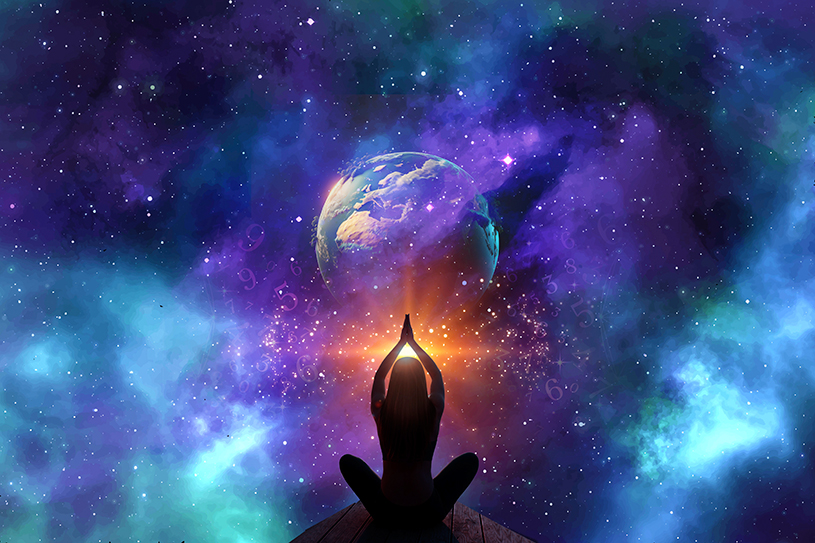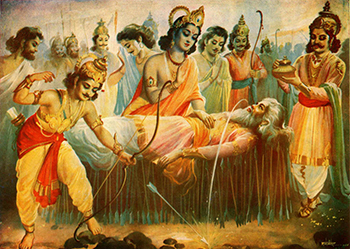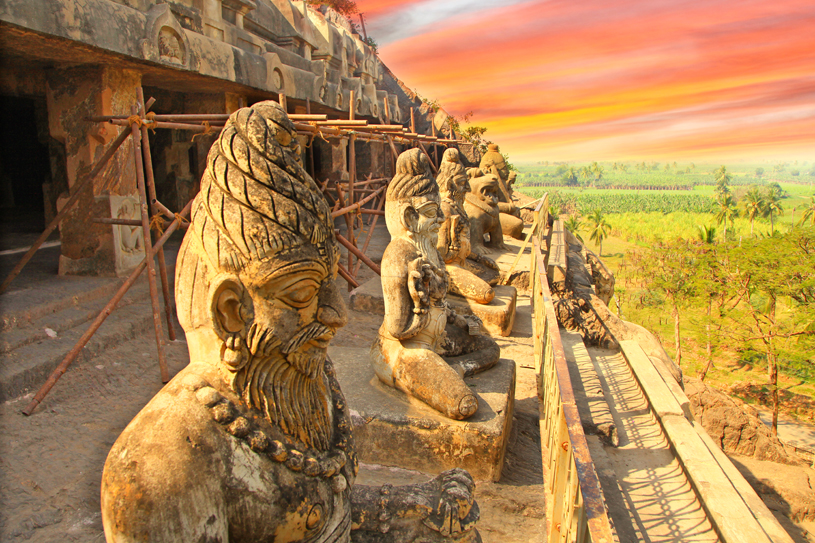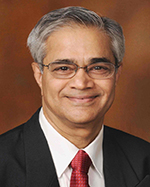Modern Physics Unravels the Significance of Sanatan Dharma

By Pradeep B. Deshpande and James P. Kowall
In Sanskrit, the word Sanatan means eternal, something that has no beginning and no end, and dharma may be loosely translated to mean duty, and so Sanatan dharma may be taken to mean eternal duty. So, what is the eternal duty of human beings?
Modern physics unravels the mystery.
The year is 1995, and high schooler Amanda Gefter is having dinner with her dad, Dr. Warren Gefter, Professor of Pathology at the University of Pennsylvania Medical School, at their favorite Chinese restaurant, House of Hunan, in Ardmore, Pennsylvania, just west of Philadelphia. During the course of the evening, Professor Gefter asks Amanda, What is nothing? Puzzled, Amanda answers, absence of something, absence of everything; why do you ask? Warren replies that the answer just might hold the key to the mystery of the beginning of the universe.
In her New York Times best-selling book, Trespassing on Einstein’s Lawn, Amanda writes that, for the first time in many years, the class-cutting and sleeping-through-classes teenager had a smile on her face. She asks her dad, So, how do we find out? Dr. Gefter replies, Let’s do some research.
They did research over the ensuing decade, buying book after book on astronomy, theoretical physics, quantum mechanics, particle physics, etc., turned a spare room into a library, and studied late into the night, when Amanda’s mom would tell them that it was very late and that they should come to bed.
The father-daughter duo found a hint here, a clue there, but no real answers. Then they decided they needed to talk to physicists.
By this time, the year is 2002, Amanda has graduated from college, and she is working at a bridal magazine called Manhattan magazine in New York City when she discovers that there was going to be a Physics and Ultimate Reality Conference at Princeton to celebrate the ninetieth birthday of famed theoretical physicist John Archibald Wheeler, a colleague of Albert Einstein at Princeton.
 Somehow, the pair manages to get two passes, pretending to be journalists, to attend the conference. When the opportunity presented itself, Prof. Gefter asked Prof. Wheeler, Who created the universe? Wheeler responded, In physics, the universe is a self-excited circuit. Amanda excitedly wrote down in her notebook, Wheeler thinks the universe came out of nothing!
Somehow, the pair manages to get two passes, pretending to be journalists, to attend the conference. When the opportunity presented itself, Prof. Gefter asked Prof. Wheeler, Who created the universe? Wheeler responded, In physics, the universe is a self-excited circuit. Amanda excitedly wrote down in her notebook, Wheeler thinks the universe came out of nothing!
In the ensuing decade, Amanda Gefter interacted with some of the best brains in physics, including Stephen Hawking, finally concluding that ultimately, nothing physical is real. The nothingness of the void creates the energy phase of the big bang, which then creates the universe. She then published her findings in the path-breaking book Trespassing on Einstein’s Lawn, mentioned earlier, in 2014.
Jim Kowall sheds light on how the nothingness of the void produces the energy phase of the Big Bang event, which then creates the universe.
In 1929, Edwin Hubble discovered that the universe was expanding. Naturally, if we went back in time, the universe would be smaller. Physicists tell us that if we continue to go back in time, some 13.8 billion years, the size of the universe would be about the size of a plank, 10-33 cm in diameter, and it would be an unbelievably hot and immensely dense energy phase.
So, on one side of the energy phase, there is this ever-expanding universe, but what’s on the other side? Kowall reasons that nothing physical can pass through the size of Plank length and be present on the other side, not even the four fundamental forces of nature (electromagnetism, gravity, strong nuclear force, and weak nuclear force) because they are physical, but consciousness can because it is not physical.
In a nutshell, then, the undifferentiated consciousness of the void creates the energy phase of the big bang event, which then creates the universe.
The reader may be reminded of the Puranic story of creation with Paratpara Shiva and Adyashakti. You may recall that Shiva is also known as Ardhanareshwar, half-male, half-female, implying that both consciousness and energy are required for creation.
His Holiness, The Dalai Lama may be seen to echo Kowall’s finding when he says, “The universe may end one day, but consciousness will remain, for it is eternal.”
Note that whatever is in the universe today was already present in the energy phase of the big bang event, albeit in unmanifest form.
To make further progress, we have to take help from the Samkhya hypothesis. The Samkhya philosophy is mentioned in the Rig Veda, and there is a chapter on Samkhya Yoga in the Bhagavad Gita.
The Samkhya hypothesis posits that all creation is made up of five principal elements: Earth (whatever is in the universe is present here on Earth), Jal (water), Agni (fire, heat), Vayu (air), and Akash (consciousness and energy), and the three Gunas (attributes) S, R, and T. The three Gunas, in turn, are correlated to the two human emotions: positive emotions and negative emotions.
Sir J. C. Bose, FRS, had shown that even plants feel pain and metals feel stress.
The upshot of the foregoing discussion is that the energy phase is our primordial source and that we should want to return to the source at the end of life. It is our Sanatan dharma.
In Hinduism, the process of returning to the source goes by the name Jeeva Samadhi, while in Buddhism, it is called Thukdam.
See this article and the video clip as examples. Russian neuroscientists and His Holiness have studied the phenomenon of Thukdam. The sages suggest that everyone readies himself or herself to return to the source over many lifetimes. What is interesting to note here is that processes that enable the seeker to return to the source also produce a shift from negative emotions to positive emotions in the seeker along the way, and therefore, these practices are worthy of adoption by everyone regardless of their place in the journey.
On the side, we all have consciousness, the differentiated kind, and thus, we too possess the capacity to create, specifically, to transform energy into matter and matter into energy, but short of the ability to create something from nothing. That capability is reserved for undifferentiated consciousness. For these reasons, sages have created terms like Aham Brahmasmi and I Am That.
Sanatan Dharma and Caste Discrimination
Lying on a bed of arrows, Sage Bhishma tells Karna in the story of the Mahabharata, In Vedic times, the Varna of individuals was determined by their capabilities. When it changed to the heredity-based caste system, no one knows. That sin was committed by leaders like me.
So, caste discrimination is both old and continues to be a scourge for Indian society. The California State Legislature has just passed an anti-caste discrimination law!
How and why does caste discrimination arise?
Everyone is endowed with a certain proportion of S, R, and T components. The proportion of each determines their level of internal excellence.
Just as individuals have a level of internal excellence, so do societies, but when it comes to societies, we speak in terms of the average level of internal excellence.
An individual with a low level of internal excellence is apt to engage in such acts as discrimination on the basis of caste.
Due to reasons that are essentially unknowable, the societal level of internal excellence undergoes transformation over time.

As the S component of a society increases, the society rises, but the S component cannot rise indefinitely, and when it reaches its peak, the T component takes over and the society begins to decline. The T component cannot rise indefinitely either, and so, when it reaches its peak, the S component takes over and society begins to rise again. The transformation of the three components induces the repeated rise and decline of societies.
Sri Krishna asserts this in the Bhagavad Gita, and we have procured substantial evidence of the rise and decline of societies from the Encyclopedia Britannica.
During Vedic times, India was on top, but it eventually declined, and after being in decline for two thousand years, it is on the rise again. However, much progress is yet to be made.
Can progress be hastened? Yes, it can, by enhancing the societal level of internal excellence, and it is not an intellectual exercise. The required positive changes have to come from within.
The S, R, and T components cannot be measured, but emotions can, and this is fortunate as internal excellence and emotional excellence are strongly and positively correlated. Increase one, and you will increase the other.
The processes with which to enhance emotional excellence are yogic processes such as meditation.
The meditative processes of Sanatan dharma that a seeker uses in the hope of returning to the source are the same ones that enhance emotional excellence.
The societal embrace of these ideas, therefore, will have a positive influence on such issues as caste discrimination.
Further Reading
- Pradeep B. Deshpande and James P. Kowall, The nature of Ultimate Reality and How It Can Transform Our World: Evidence from Modern Physics; Wisdom of YODA, amazon, 2015.
- Pradeep B. Deshpande, Gautam Gupta, Mahendra Sunkara, and James P. Kowall, How Scientists Can become Super Inventors, August 2023 (https://engrxiv.org/preprint/view/3196).
- Pradeep B. Deshpande, Transforming Higher Education, https://www.highereducationdigest.com/transforming-higher-education-temp/
- Pradeep B. Deshpande, The Secret of Exemplary Performance, Insights, August 2019 (https://www.aacsb.edu/insights/articles/2019/08/the-secret-of-exemplary-performance).
- Pradeep B. Deshpande, The Missing Piece in the Pursuit for Peace, News India Times, August 18, 2023 (2023 (https://www.newsindiatimes.com/opinion-the-missing-piece-in-the-pursuit-for-peace/).
 ABOUT THE AUTHORS
ABOUT THE AUTHORS
Pradeep B. Deshpande is Professor Emeritus in and former Chairman of the Chemical Engineering Department at the University of Louisville. He is also president of Six Sigma and Advanced Controls based in Louisville, Kentucky. He is an author of eight books and over one hundred fifty articles in reputed journals that include Proc. Royal Society–UK, Chemical Eng. Progress, Ind. Eng. Chem. Proc. Des Dev, Chem. Eng. Science, among several others He is a recipient of several international awards and is a Fellow of ISA.
James P. Kowall is an independent researcher based in suburban Eugene, Oregon. Jim obtained his MD from the University of Miami and a PhD in Theoretical Physics from Brown University. Dr. Kowall is a triple board certified physician (Neurology, Internal Medicine, and Sleep Disorder Medicine). He retired from private medical practice about a decade ago to spend time researching the nature of ultimate reality. He succeeded in 2014.























